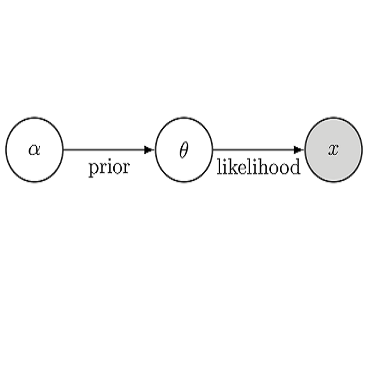Inverse problems are ubiquitous in nature, arising in almost all areas of science and engineering ranging from geophysics and climate science to astrophysics and biomechanics. One of the central challenges in solving inverse problems is tackling their ill-posed nature. Bayesian inference provides a principled approach for overcoming this by formulating the inverse problem into a statistical framework. However, it is challenging to apply when inferring fields that have discrete representations of large dimensions (the so-called "curse of dimensionality") and/or when prior information is available only in the form of previously acquired solutions. In this work, we present a novel method for efficient and accurate Bayesian inversion using deep generative models. Specifically, we demonstrate how using the approximate distribution learned by a Generative Adversarial Network (GAN) as a prior in a Bayesian update and reformulating the resulting inference problem in the low-dimensional latent space of the GAN, enables the efficient solution of large-scale Bayesian inverse problems. Our statistical framework preserves the underlying physics and is demonstrated to yield accurate results with reliable uncertainty estimates, even in the absence of information about underlying noise model, which is a significant challenge with many existing methods. We demonstrate the effectiveness of proposed method on a variety of inverse problems which include both synthetic as well as experimentally observed data.
翻译:从地球物理学和气候科学到天体物理学和生物机械学等几乎所有科学和工程领域都普遍存在反向问题,从本质上说,这些问题都是普遍存在的,从地球物理学和气候科学到天体物理学和生物机械学等几乎所有科学和工程领域都存在。在这项工作中,解决反向问题的主要挑战之一是解决其不正确的性质。贝叶斯推论提供了一种原则性方法,通过将反向问题纳入统计框架来克服这一问题。然而,在推断具有大维面(所谓的“维度诅咒”)离散现象的领域和(或)以前只有以以前获得的解决办法形式获得信息的领域时,采用这种方法是具有挑战性的。在这项工作中,我们提出了一种高效和准确的贝叶斯反向反向方法,具体地说,我们展示了如何使用一个基因反向的Adversarial网络(GAN)所学到的大致分布方法,作为以前一种将这一问题纳入统计框架的统计框架,从而能够有效地解决大规模巴伊斯反向问题。我们的统计框架维护了基础物理学的基础和准确的反向反向反向反向反向转换的方法,我们展示了一种精确的预测的方法。我们所观察到的可靠地展示了各种方法。




